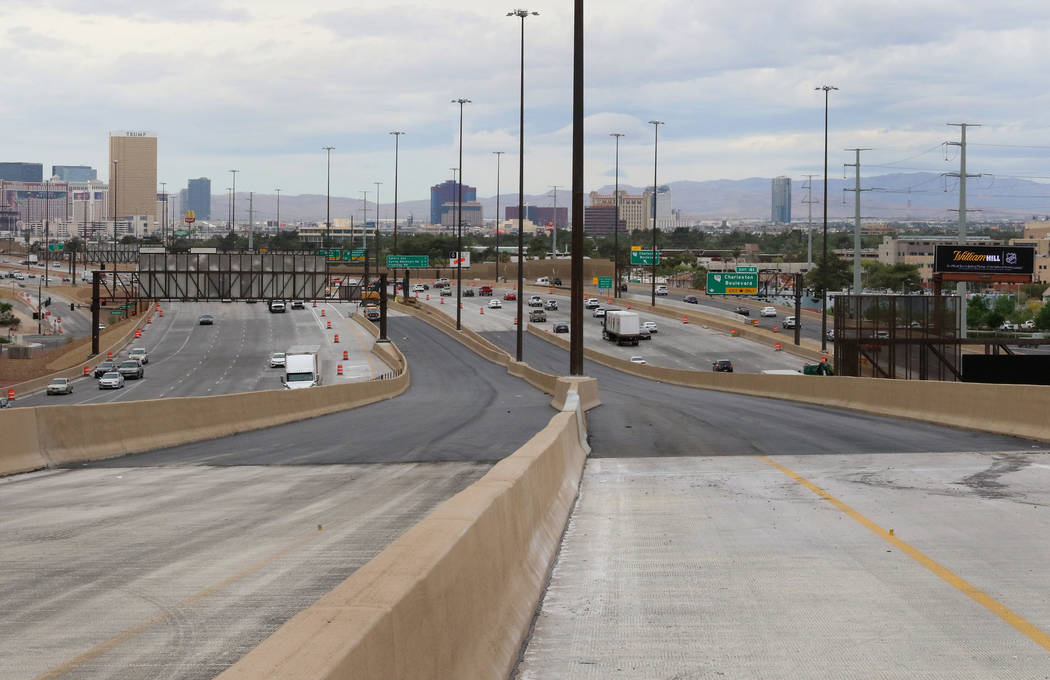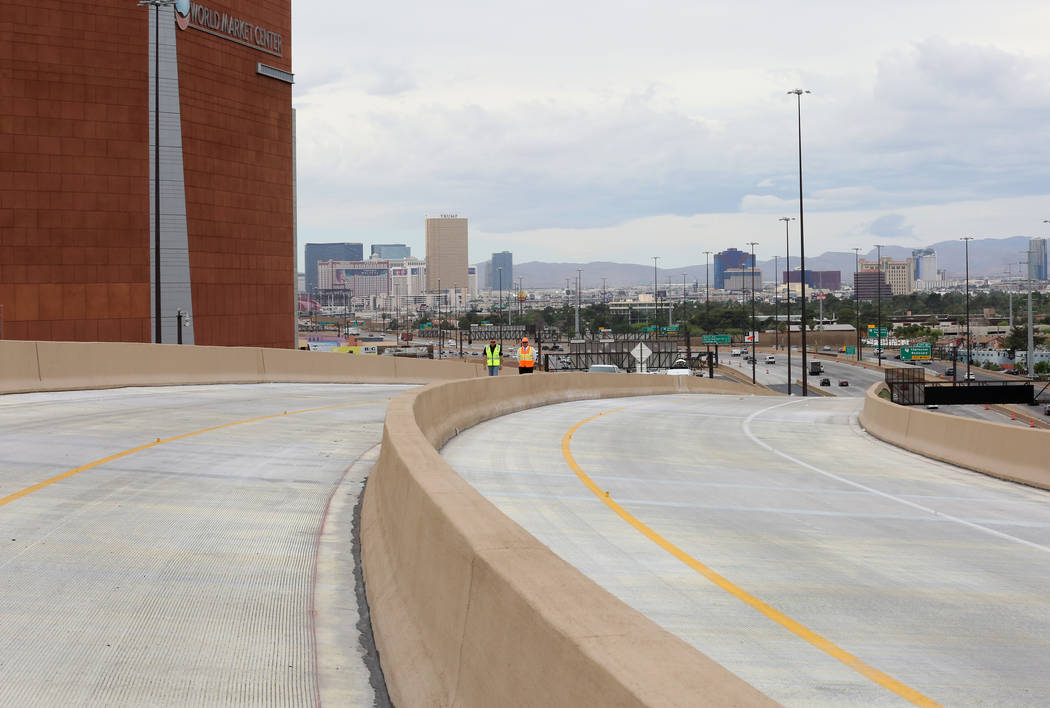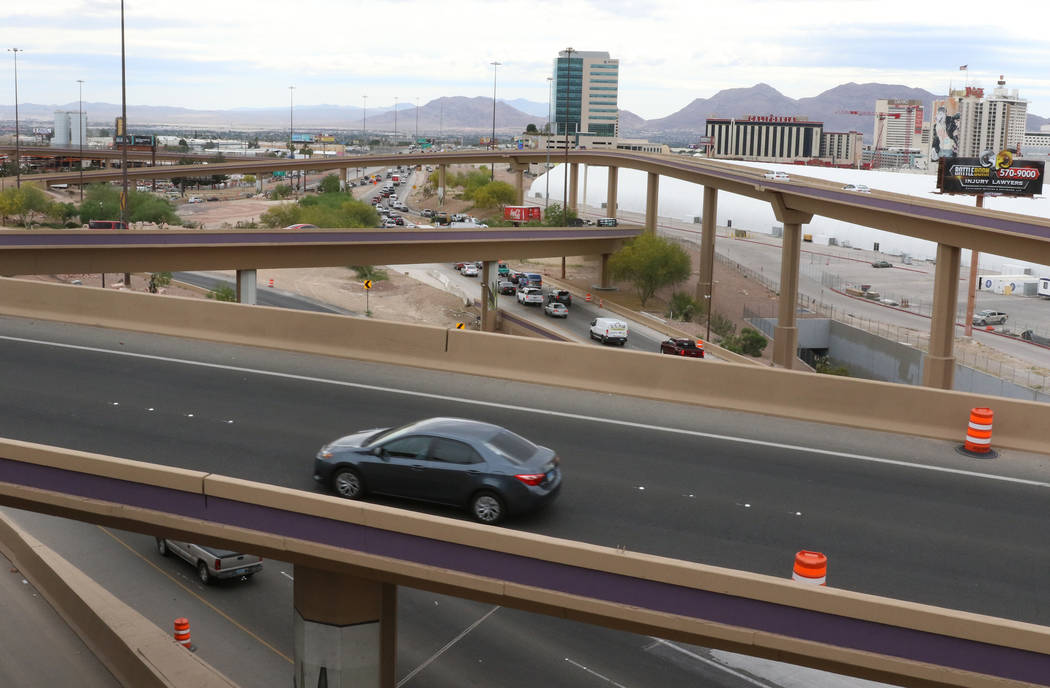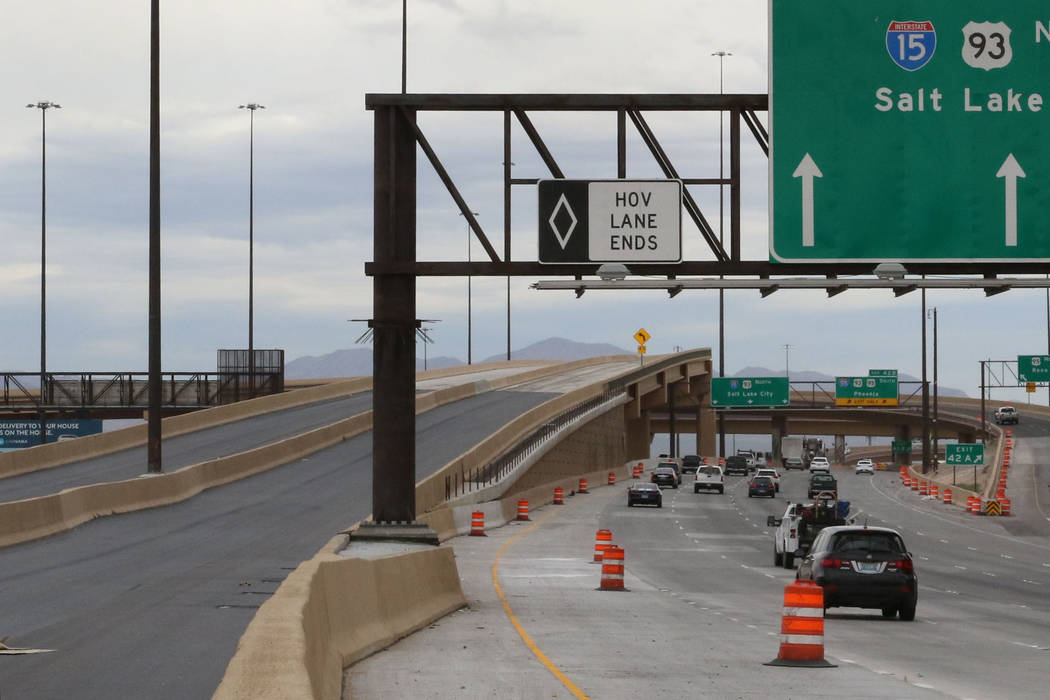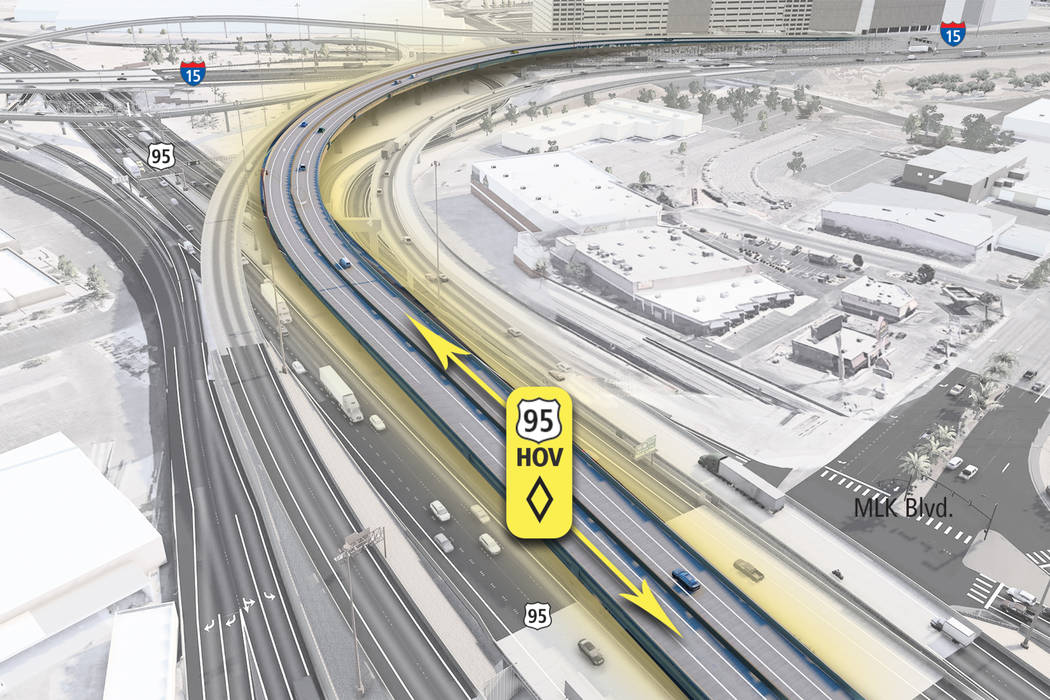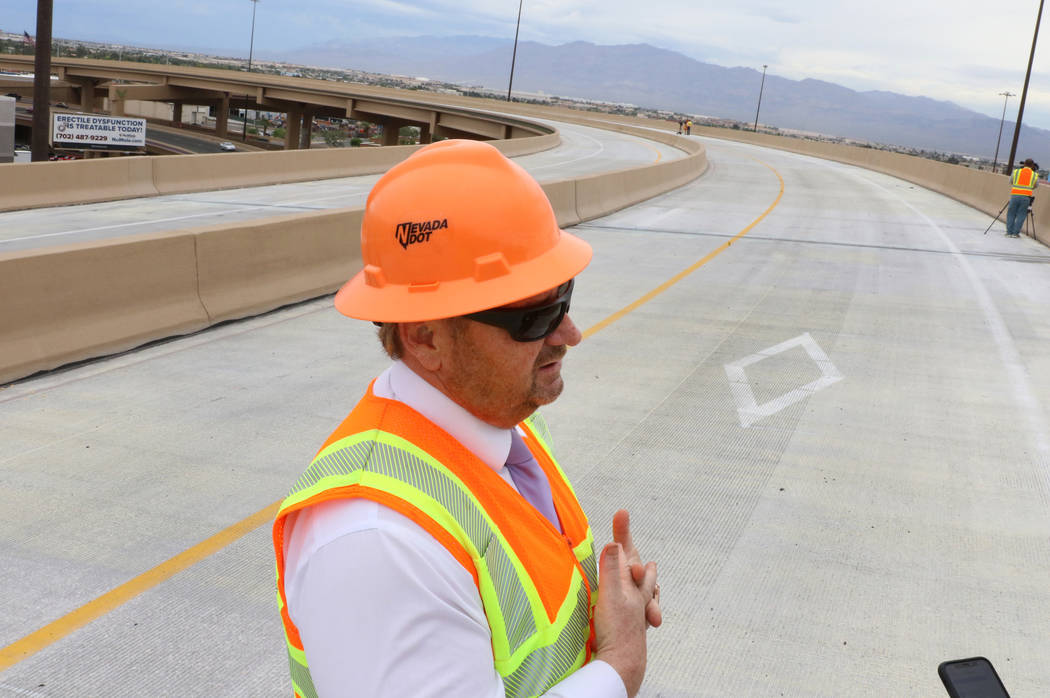Las Vegas motorists have 22 miles of new HOV lanes
The 22 miles of high occupancy vehicle lanes slated to go online Monday have been in the works for over a decade.
Despite that lead time, not everyone is ready for them, or for 24-hour-a-day enforcement.
“The problem with HOV lanes is twofold,” said retired Air Force veteran James Tilley. “First, there is little if no enforcement. At least 50 percent of the vehicles on the southbound 95 HOV lanes only have one driver. (Second) By designating an HOV lane, it removes it from usage by other drivers thus adding to the congestion in the non-HOV lanes.”
The Nevada Department of Transportation touts HOV lanes as more efficient than a general purpose lane, as they carry more people in fewer cars. That leads to reduced fossil fuel consumption and better air quality through less emissions while limiting vehicle wear-and-tear, NDOT said.
The department also said carpool lanes are safer and less stressful, with fewer cars cutting in and out of lanes.
“Carpooling, after all, is just another name for ridesharing, which is being touted as the future of transportation,” said Tony Illia, NDOT spokesperson. “Certainly, carpooling is nothing new to the millions of Southern California visitors and transplants that now call the Las Vegas valley home.”
NDOT’s HOV plan calls for converting the current two express lanes on Interstate 15 in the resort corridor into one general purpose lane and one HOV lane in each direction. Those lanes will connect with existing HOV lanes on U.S. 95 via the centerpiece of Project Neon, the 81-foot-tall, 2,600-foot-long HOV flyover bridge.
That connection is now finished and ready for Monday’s launch of a single continuous HOV lane in each direction stretching from Silverado Ranch Boulevard on I-15 to Elkhorn Road on U.S. Highway 95.
Rep. Peter DeFazio, D-Ore., the chairman of the U.S. House Transportation and Infrastructure Committee, questioned the wisdom of converting an existing express lane into an HOV lane.
“The original theory is to try to encourage carpooling and carpooling in modern society is pretty difficult for a lot of people,” DeFazio told the Las Vegas Review-Journal. “They obviously have to be flexible in terms of implementing it and how they utilize it. But, I can see how that (converting an existing lane into an HOV lane) could be controversial.”
Round-the-clock enforcement
Currently, the HOV lanes on U.S. 95 are regulated between 6 a.m. and 10 a.m. and 2 p.m. and 7 p.m. Monday-Friday. The lanes are considered general purpose lanes outside of the restricted hours and throughout weekends.
Once the new HOV lanes are in operation Monday morning, enforcement will change to 24 hours a day, seven days a week.
The all-day policing of the lanes goes against the grain nationally, DeFazio said.
“That’s interesting,” he said. “I’m not aware of many places that have 24-hour a day HOV lanes. Most are doing them during peak hours of the day, so 24-hour HOV lanes is a new one to me.”
A recent poll conducted by Las Vegas officials on the city’s Facebook page revealed 59 percent of the almost 2,000 people that voted said they were in favor of carpool lanes. However, most of the commenters said they supported intermittent enforcement, as opposed to round-the-clock.
“I support HOV lanes during morning and afternoon rush hour time frames,” Larry Shultz said on the Facebook thread. “During non-rush hour time frames, these lanes should be open to all drivers.”
David Frommer, executive director for planning and construction at UNLV, said 24-hour enforcement is the right way to go at first, but said it may be necessary to reevaluate the approach in the future.
“I think it’s good to start with a plan and see how it goes,” Frommer said. “Then as time goes on, you can see if you revise the plan to incentivize the lanes the most we can, during certain hours where congestion is the worst, and other hours maybe looking at changing the approach. You’ve got to start somewhere and then see how you can modify that.”
NDOT said it will continuously monitor data regarding the HOV lanes and make the necessary adjustments.
But don’t expect any changes anytime soon. Las Vegas public works director Mike Jansen said during Wednesday’s city council meeting that any change of HOV regulations, including the 24-hour enforcement, is years away.
“The commitment I was able to get was that NDOT wants to have no less than a three-year period to evaluate these facilities,” he said. “If the data after that three-year period showed that they are not needed to be full time, then they would be willing to look at converting them back to part time.”
Carpool usage
NDOT and the Federal Highway Administration both said there are no nationally recognized HOV lane data averages. But NDOT has numbers for the existing HOV lanes on U.S. 95.
General travel on U.S. 95 between Craig Road and Decatur Boulevard ranged from 110,490 to 32,680 vehicles per day on average in 2018, NDOT said. Carpool lane usage on that same stretch ranged from 21,484 to 10,644 per day last year.
NDOT expects use of the lanes will rise now that they will run uninterrupted for 22 miles.
“Motorists previously had to swerve in-and-out of HOV lanes to make freeway-to-freeway connections,” Illia said.
The agency anticipates an average of 700 vehicles per hour for an HOV lane, or 16,800 a day. It also envisons 500 vehicles per hour on the freeway-to-freeway flyover ramp and 250 vehicles per hour utilizing the HOV drop ramps that will allow access to downtown.
If the HOV lanes prove not to be utilized as NDOT hopes, a possible option would be to convert them to high occupancy toll, or HOT, lanes.
HOT lanes work like HOV lanes, except those driving without passengers can utilize the lanes by paying a toll. The lanes are free for those meeting the carpool requirements.
NDOT attempted to have that included in the HOV plan tied to Project Neon, but wasn’t able to have the legislation in place in time. There are no immediate plans for NDOT to seek legislation for the toll lanes, Illia said.
If NDOT eventually sees the HOV lanes not serving their purpose, it also could decide to convert the lanes to general use lanes down the line. If that were to occur, however, it could prove costly as federal money is tied to the HOV implementation.
“Congestion Mitigation and Air Quality funding is tied to the HOV system, which would need to be reimbursed to the Federal Highway Administration if the carpool lanes were to be converted back to general purpose lanes in the future,” Illia said.
An exact figure for that funding wasn’t immediately available from NDOT.
Despite the differing views on HOV lanes and their regulations, the time is right to bring HOV lanes on board, said Frommer.
“In the transportation world a lot of discussion is centered around how many people are you moving along those lane miles,” he said.“If you can move more people in fewer or the same amount of vehicles that seems like that’s part of the transportation puzzle.”
Contact Mick Akers at makers@reviewjournal.com or 702-387-2920. Follow @mickakers on Twitter.
HOV rules
There are multiple ways for a motorist to violate the new HOV lane regulations, in turn facing a $250 fine. Infractions include:
• Vehicles that don't enter or exit the carpool lane at one of the broken line enter/exit points.
• Vehicles with one occupant.
• Electric cars, unless with two occupants, as per Nevada law.
• Trucks with more than two axles, even with two occupants.
There will be a 30-day grace period after the new HOV regulations go into effect before Nevada Highway Patrol troopers and Metropolitan Police officers will begin issuing tickets for carpool lane violations.



